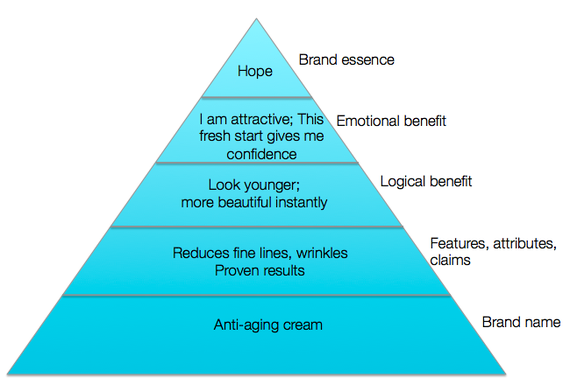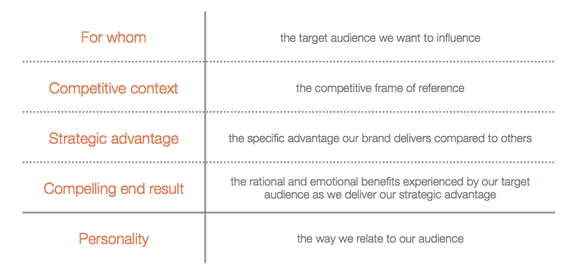Can you name the brands associated with the following taglines? "Just do it." "Think different." "Moving at the speed of business." I bet you named at least one, if not all. In case you aren't sure, they represent Nike, Apple and UPS, respectively. These companies have created legacy brands that are lodged in people's minds in ways that profoundly differentiate them from their competitors.
What is a brand? In its simplest form, I think of a brand as something that happens in your customer's mind every time they hear your name. It is the expectation or mental shortcut that is triggered.
For example, for me, Campbell's chicken noodle soup has less to do with soup, and more to do with my memory of what my mother fed me when I was a sick child. Campbell's therefore triggers an expectation of comfort in my mind -- and thus better competes for my loyalty against other soups.
How do you go about building a positive brand that is compelling to customers, focuses your team and differentiates you from the competition?
Here are my favorite five brand habits:
1. Distill your brand essence.
Many companies are clear on their features and even logical benefits, but stop short of articulating the emotional benefits and their brand essence. Let's use a brand pyramid -- a tool first shared with me by brand expert Deborah Scott at Amazon.com -- to illustrate this point. 
Your product's name goes at the bottom. In this example, we will use an anti-aging cream.
Next, look at your product attributes. What are its key features? This anti-aging cream diminishes wrinkles.
Now, define the logical benefits by completing the following statement: "When a customer purchases my product or service, the benefit they receive is ____________." In our example, customers benefit by looking younger and more attractive.
The fourth step is to identify the emotional rewards. Ask yourself: "How should my customers feel?" The anti-aging cream makes its users more attractive, but the emotional benefit is the confidence that ensues.
Finally, and most importantly, top your pyramid with your brand essence. The anti-aging cream is ultimately about hope. Think about that. A brand essence like "hope" creates a very different lens through which you will market your product than "reducing wrinkles" and is what will really compel customers to adopt your product.
2. Articulate your brand's positioning statement
Writing out a positioning statement forces you to sharpen your thinking about key aspects of your brand like target audience, competitive differentiation and brand personality.
Below is a framework, inspired by branding guru David Aaker, that you can use. Fill in the answers to the right and your positioning statement will unfold. The result will be an important guidepost you can use to focus your team, force tradeoffs and inform anyone working with you on your business objectives.
Take the time to generate crisp responses. Gather insights about your industry, research the strengths and weaknesses of your existing brand, and develop a tight, firm vision about what you stand for.
3. Ask your customer.
I began this post by sharing some iconic taglines. At my company, oDesk, we rewrote our tagline a couple of years ago. I'll use this example to illustrate the value of asking for customer feedback.
Our effort began with an internal contest. We selected our five best tagline submissions, but decided to let our customers guide us to the final decision.
We researched our tagline options with hundreds of prospective customers.
An indisputable winner emerged. "Love the way you work" elicited an overwhelming number of positive comments and emotions, and 0 percent net negative comments.
Postscript to this research: Looking at our results and at other popular taglines, I am struck by a consistent theme. They involve action and they directly engage the customer. Take another look and see if you agree:
"Just do it." "Think different." "Love the way you work."
4. Prize customer experience.
So far, we have discussed marketing and positioning. However, nothing trumps actual customer experience. Nothing. Every time a customer encounters your brand -- before, during and after their purchase -- he or she has an experience that can be anything from delightful to downright awful, thus burnishing or tarnishing your brand. Smart companies track the customer experience every step of the way, with an eye towards continuous improvement.
In 1999, I worked at Amazon.com, a company explicitly committed to delighting customers. Leading into the holiday season that year we were inundated with orders. Everyone -- from engineers to execs -- headed for the warehouses to pick, wrap and ship orders. After the official deadline for Christmas orders had passed, we upgraded shipping on some packages to exceed expectations and ensure Christmas delivery. Some employees then hand-delivered packages on their way home for Christmas Eve, astonishing customers one at a time.
This not only thrilled our customers; it also reinforced to employees the commitment to customer delight that Amazon.com prizes. After all, I am still talking about it almost 14 years later!
5. Spread the love.
What customers say about your brand is inherently credible and can amplify your key messages. Building customer loyalty does not require a million-dollar budget. It does require a genuinely positive experience. You then need to engage with customers in ways that motivate them personally to extend your reach.
At oDesk, for example, we recently reached an important milestone -- $1 billion spent on hiring via our online workplace. We felt compelled to celebrate and sent congratulatory emails to our top customers. Within a few days, these professionals had shared their accomplishment via social media more than 1,650 times, exposing our brand to countless friends and followers. 
There are many different ways to approach building a strong brand; these are my favorite five. Do you have insights to share? I'd love to hear them!
